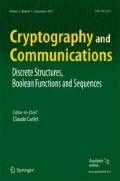Abstract
Multimedia fingerprinting is an effective technique to trace the sources of pirate copies of copyrighted multimedia information. Separable codes can be used to construct fingerprints resistant to the averaging collusion attack on multimedia contents. In this paper, we first show an equivalent condition of a \(\overline {2}\)-SC (4,M,q), and then construct two infinite families of \(\overline {2}\)-SCs of length 4, one of which is asymptotically optimal.
Similar content being viewed by others
References
Blackburn, S.R.: Frameproof codes. SIAM J. Discret. Math. 16, 499–510 (2003)
Blackburn, S.R.: Probabilistic existence results for separable codes. IEEE Trans. Inf. Theory 61, 5822–5827 (2015)
Boneh, D., Shaw, J.: Collusion-secure fingerprinting for digital data. IEEE Trans. Inf. Theory 44, 1897–1905 (1998)
Cheng, M., Fu, H.-L., Jiang, J., Lo, Y.-H., Miao, Y.: New bounds on \(\overline 2\)-separable codes of length 2. Des. Codes Cryptogr. 74, 31–40 (2015)
Cheng, M., Ji, L., Miao, Y.: Separable codes. IEEE Trans. Inf. Theory 58, 1791–1803 (2012)
Cheng, M., Miao, Y.: On anti-collusion codes and detection algorithms for multimedia fingerprinting. IEEE Trans. Inf. Theory 57, 4843–4851 (2011)
Gao, F., Ge, G.: New bounds on separable codes for multimedia fingerprinting. IEEE Trans. Inf. Theory 60, 5257–5262 (2014)
Hollmann, H.D.L., Lint, J.H., Linnartz, J.-P., Tolhuizen, L. M.G.M.: On codes with the identifiable parent property. J. Combin. Theory, Ser. A 82, 121–133 (1998)
Staddon, J.N., Stinson, D.R., Wei, R.: Combinatorial properties of frameproof and traceability codes. IEEE Trans. Inf. Theory 47, 1042–1049 (2001)
Stinson, D.R., van Trung, T., Wei, R.: Secure frameproof codes, key distribution pattern, group testing algorithms and related structures. J. Stat. Plan. Inference 86, 595–617 (2000)
Trappe, W., Wu, M., Wang, Z.J., Liu, K.J.R.: Anti-collusion fingerprinting for multimedia. IEEE Trans. Signal Process 51, 1069–1087 (2003)
Acknowledgments
The authors express their sincere thanks to the two anonymous reviewers for their valuable comments and suggestions in revising this paper, and to the editor for his/her excellent editorial job.This work is in part supported by NSFC (No.11301098), Guangxi Natural Science Foundations (No.2013GXNSFCA019001 and 2014GXNSFDA118001), Guangxi Higher Institutions’ Program of Introducing 100 High-Level Overseas Talents, Guangxi Collaborative Innovation Center of Multi-source Information Integration and Intelligent Processing, and Guangxi “Bagui Scholar” Teams for Innovation and Research.
Author information
Authors and Affiliations
Corresponding author
Rights and permissions
About this article
Cite this article
Cheng, M., Jiang, J. & Tang, X. Asymptotically optimal \(\overline {2}\)-separable codes with length 4. Cryptogr. Commun. 9, 397–405 (2017). https://doi.org/10.1007/s12095-016-0182-9
Received:
Accepted:
Published:
Issue Date:
DOI: https://doi.org/10.1007/s12095-016-0182-9


